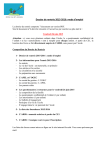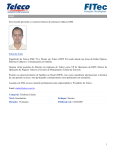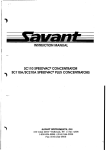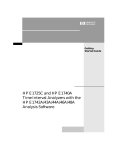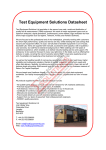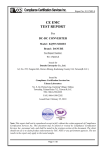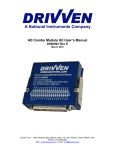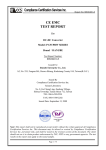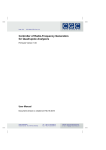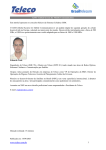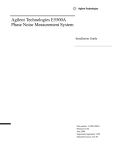Download A Flexible Waveform Generator Using OmniSys and Instrumentation
Transcript
Solutions from HP EEsof A Flexible Waveform Generator Using OmniSys and Instrumentation Product Note E4600-9 Overview The Series IV OmniSys software now has the capability of interfacing to instruments that can generate test signals. The flexibility of OmniSys allows a wide variety of signals to be simulated, which can then be generated by the instruments. This allows systems to be tested even when some subsystems have not been completed. Applications include generation of IS-95 CDMA signals, both ideal and those impaired by fading channels. This product note describes the software and hardware requirements and how they should be configured. The C-code that implements the interface is described. Examples of how to generate an ideal IS-95 pilot signal and one that is faded are also provided. Introduction This product note describes the interface between the OmniSys system simulator and the HP 1445A Arbitrary Function Generator (hereafter referred to as the ARB). This hardware-software link provides a flexible method for generating waveforms. OmniSys generates samples of the desired waveform; the samples are then fed to the ARB, which generates the corresponding analogue waveform. Baseband signals can be generated directly by this method. RF waveforms, such as the IS-95 CDMA or the GSM 0.3GMSK, can be generated using OmniSys to compute the inphase and quadrature samples of the waveform, using two ARBs to generate the corresponding analogue waveforms, then using the HP ESG-D series signal generators to modulate the waveforms to the RF frequency (see Figure 1). VXI card cage HP Unix workstation with OmniSys Inphase component HPIB card Filters (if needed) Modulator RF output Quadrature component HPIB controller ARB ARB Figure 1. Setup for Generating RF Signals With OmniSys, samples of ideal waveforms can be generated, or samples of waveforms resulting from impairments such as non-linear amplifiers, phase noise, or fading channels A Flexible Waveform Generator Using OmniSys and Instrumentation can be generated. This can reduce the instrumentation required for testing transmitters and receivers or individual components such as amplifiers and mixers. OmniSys Basics Some basics about OmniSys that are relevant to the ARB interface are described in this section. Figure 2 shows the schematic of an IS-95 CDMA transmitter for the pilot channel. TStop=26680 TStep-0.203 DSP RF Figure 2. Typical OmniSys Schematic (IS-95 CDMA Pilot Channel Transmitter) It is important to note that the sampling period of the samples at the output of the CLOCK source are specified by TStep, and all other signals in this design, except for the output of the downsampler, have the same sampling period (sampling rates can be changed only by using multi-rate devices such as an upsampler or a downsampler). The simulation runs from time 0 to TStop, and the samples of the signal at every node are indexed with the values 0 • TStep, 1 • TStep, 2 • TStep, ... , N • TStep, where N is the largest integer such that N • TStep ≤ TStop. The DSP portion of the schematic processes samples of baseband signals. These samples can be sent directly to the ARB to generate the corresponding waveform. In the RF portion of the schematic, signals are represented by the inphase (xi(t)) and quadrature components (xq(t)), and the carrier frequency (ω). The corresponding RF waveform can be generated by the following equation x rf ( t ) = x i ( t ) cos ( ωt ) – x q ( t ) sin ( ωt ) Therefore, to generate the corresponding RF waveform, the inphase and quadrature components must be first generated with the ARBs, and then modulated up to the carrier frequency using an HP ESG-D series signal generator. The inphase and quadrature components of an RF signal can be extracted in OmniSys by using a DEMQAM element. For example, to generate the signal at the output of the bandpass filter labeled BPFC, a DEMQAM element must be placed as shown in Figure 3. 2 A Flexible Waveform Generator Using OmniSys and Instrumentation Fc=10 In-phase component Quadrature component TStop=26680 TStep-0.203 Fc=10 DSP RF Figure 3. Extracting Inphase and Quadrature Components of an Omnisys RF Signal HP 1445A Arbitrary Function Generator Basics The HP 1445A is a programmable arbitrary function generator. It contains a 13-bit D/A with enough memory to store 256K samples, which can be loaded through the VXI bus. The samples can be clocked out at a clock rate that can be varied from 0.01 samples per second up to 21.47483648 Msamples per second, with a resolution of less than 0.02 samples per second (a 40-MHz clock is also available, but is not used in the OmniSysARB interface). This variable clock is generated by the reference oscillator, DDS, DAC, filter combination shown in Figure 4. The ARB clocks data out in a cyclic manner, that is, after clocking out the last sample it starts with the first sample again. A continuous waveform is generated in this manner. 10 Mhz filter VXI bus Reference Oscillator Memory 13 bit DAC DDS DAC 250 Khz filter Filter Attenuator clock clock Figure 4. ARB Block Diagram Certain parameters of the ARB can be controlled from OmniSys. For example, the maximum amplitude of the output can be set to be in the range 0.1 to 5.1V. The output 3 A Flexible Waveform Generator Using OmniSys and Instrumentation impedance can be set at either 50 or 75 ohms. If required, the ARB has two filters at its output; either the 250 kHz or the 10 MHz filter can be selected. For generating RF signals, two ARBS are required, one for the inphase component and one for the quadrature component. The ARBs must be synchronized so that they clock out the data in step. This is automatically done by OmniSys by configuring the ARBs in a master-slave configuration, where the clock of the master ARB is also used to clock out the data of the slave ARB. The outputs of the ARBs must then be fed to an HP ESG-D series signal generator, which modulates the signals to the appropriate carrier frequency. ESG-D Series Digital Signal Generator Basics The ESG-D series of digital and analog signal generators can accept inphase and quadrature inputs and quadrature modulate the signals on to a carrier whose frequency can be varied up to 4 GHz (different ESG models have different specs, so please refer to the data sheets for details about a particular model). The full scale input, I 2 + Q 2 , equals 0.5V rms (for certain signals with a large peak to rms value, such as IS-95 CDMA signals, the peak-to-peak value of each of the I and Q inputs should, at most, be 0.5V). The 1dB bandwidth of the inphase and quadrature input signals can be up to 10 MHz. The output magnitude accuracy (rms) is maintained within 0.75 percent over the 4-GHz range; the phase error (rms) is maintained within 0.5 degrees, the origin offset is less than −40 dBc; and the EVM (rms) is less than 1 percent. OmniSys-ARB Interface The OmniSys interface to the ARB is provided through either the ARB1 or the ARB2 device located in the arb library (see Figure 5). The ARB1 device with one input is the interface to a single ARB; the ARB2 device with two inputs (one for the inphase component and one for the quadrature component of the signal) is the interface to two ARBs in the master-slave mode. The ARB1 interface can be used to generate baseband signals or RF signals at a low carrier frequency; the ARB2 interface can be used in conjunction with an HP ESG-D series signal generator to generate RF signals at high carrier frequencies. Figure 5. OmniSys-ARB Interface Because data is sent from the simulator to the ARB through an HPIB bus, the workstation where the OmniSys simulator runs must be equipped with an HPIB card (E2071C Plug&Play HPIB Card for HP-UX). The user-settable parameters for the ARB1 device follow. Start specifies the time index of the first sample that should be sent to the ARB. If there is no sample corresponding to this time index, then the sample with the smallest time index greater than Start is the first sample sent. 4 A Flexible Waveform Generator Using OmniSys and Instrumentation Stop specifies the time index of the last sample that should be sent to the ARB. If there is no sample corresponding to this time index, then the sample with the largest time index less than Stop is the last sample sent. The Start and Stop parameters should satisfy the condition 0 ≤ Start < Stop ≤ TStop (where TStop is specified in the control item). MaxAmplitude specifies the maximum amplitude of the output signal of the ARB. The ARB is automatically programmed so that the gain of its output attenuator equals this value. (The amplitude of the ARB output is independent of the amplitude of the signal at the input to the ARB device in the simulation.) The input samples are automatically scaled so that the entire dynamic range of the DAC is used, and the final output of the ARB is then controlled with the output attenuator. Filter specifies the output filter (if any) of the ARB: 250 kHz or 10 MHz. Impedance specifies the output impedance of the ARB: 50 or 75 ohms. DataAvg specifies the method by which the sample points are to be averaged. Smoothing the data may help in mitigating the effects of any discontinuity between the first and last points in the data. • The 3-point average modifies all data points as follows: x [ i ] ⇐ ( x [ ( i – 1 )mod L ] + x [ i mod L ] + x [ ( i + 1 )mod L ] ) ⁄ 3 , where 0 ≤ i < L, and L is the length of the data array. • The end point average modifies only the first and the last data points as follows: x [ 0 ] ⇐ x [ 0 ] – ( x [ 0 ] + x [ L – 1 ] )2 and x[ L – 1] ⇐ x[ L – 1] – ((– x[0] + x[ L – 1] ) ⁄ 2) PrimAddr SecAddr specifies the primary address of the ARB specifies the secondary address of the ARB The ARB is addressed using the primary and secondary addresses (iopen (hpib, primary address, secondary address)) where the iopen( ) function is defined in the SICL library. To check the address of the ARBs, remove the card and check the switch settings. If the switch settings for the master and slave ARBs are 80 and 88, respectively, then the SecAddr for the master slave ARBs should be specified as 10 and 11, respectively, in OmniSys. (In general, the secondary address specified in OmniSys equals the switch setting divided by 8.) Refer to figure 1-2 on page 1-5 of the ARB manual [3] for details on the switch settings. The OmniSys ARB2 device has the same parameters except that the primary and secondary addresses of both ARBs must be specified (it does not matter which ARB is designated as the master or the slave). Practical Considerations for Using the Link If multirate elements are not used, the minimum value of TStep that can be specified in an OmniSys simulation is 1/21.47483648 µsec; if multirate elements are used, ensure that the sampling period of the signal at the input to either the ARB1 or ARB2 devices is greater than 1/21.47483648 µsec). This is because the maximum clock rate for the ARB is 21.47483648 MHz. Given this maximum sampling rate, the largest bandwidth signal that can be theoretically generated equals 10.73741824 MHz. However, due to practical filtering considerations, the actual bandwidth that can be accommodated will be smaller. Filtering can be done external to the ARB if the 250 kHz and 10 MHz filters available with the ARB are not suitable for a particular application. 5 A Flexible Waveform Generator Using OmniSys and Instrumentation The D/A will introduce a sinc(f) distortion to the spectrum of the output signal. If the sampling rate is much greater than the bandwidth of the signal, this distortion is typically not significant. If this is significant, an inverse 1/sinc(f) filter can be created in OmniSys to compensate for the distortion. This can be done by using the LPFRCI (lowpass raised cosine filter), located in the Functional Filter Elements category of the OmniSys library. Set the parameters of this filter as follows: F (bandwidth of filter) A (roll-off factor) set equal to the bandwidth of the signal. set equal to 0. Type set equal to Pulse or Impulse with eq. (this adds a 1/sinc(f) term to the transfer function of the filter). E (shaping exponent) set equal to 1. Delay (delay added to ideal response to make it causal) set to be at least 4/F. WindowType select the type of window required. The schematic in Figure 6 shows how the filters are used in the CDMA design. F=1.2288 A=0 Type=Pulse E=1 Delay=4 Figure 6. Using OmniSys Filters to Provide 1/sinc Compensation Because the ARB outputs the data cyclically, any discontinuities between the last and the first data points must be avoided. (A discontinuity can cause spurious frequencies in the analogue signal.) Manually examine the waveform in OmniSys and pick the start and end data points so that they match. The DataAvg parameter provides some simple algorithms to smooth the data (refer to the previous section for DataAvg details). As an aid to debugging the ARB link, the commands sent to the ARB are saved in the file ArbCommandsDebug_hpibaddr.log, where hpibaddr equals the primary address followed by the secondary address (for example, the commands sent to the ARB with primary address 9 and secondary address 10 is saved in the file ArbCommandsDebug_910.log). Error messages returned by the ARB are saved in the ArbErrorMsgs.log file. 6 A Flexible Waveform Generator Using OmniSys and Instrumentation Example 1 The example in Figure 7 illustrates how an ideal pilot tone CDMA signal for the forward link of the IS-95 standard can be generated. Figure 7. OmniSys Schematic for Generating an IS-95 CDMA Pilot Signal The schematic shows a clock that clocks two linear feedback shift registers that generate the short codes for the I and Q channels of the pilot channel (the pilot channel of the forward link contains only the short codes; actually the 0th Walsh code, which is all zeros is used and therefore is not included in the schematic. To generate a traffic channel, the Walsh code must be considered). The sampling period of the simulation, TStep, is set such that there are 4 samples per chip. The down-sample element discards 3 of the samples and the up-sample inserts 3 zeros. The input to the FIR filter now consists of 4 samples per chip, where one sample is the actual value of the chip and the remaining 3 are zeros. The PN sequences are then filtered with FIR filters whose tap coefficients are listed in the IS-95 specification. The outputs of the filters are the inphase and quadrature phase components of the final RF signal. The FIR outputs are then fed to an ARB2 device, whose outputs are in turn connected to an HP ESG-D series signal generator and modulated up to the required frequency. The sampling period, TStep, in the simulation is chosen to be 0.2034505208333 µsec, which gives 4 samples per chip. The FIR filters have been specified for this sampling rate. The bandwidth of the signal at the output of the FIR filters is approximately 600 kHz. This implies that the lower end of the image of the spectrum will lie at approximately 4.3 MHz (4.3 = (1/0.2034505208333) − 0.6). Therefore, external filters are needed because neither of the ARB filters will get rid of the image frequencies. The Start and Stop parameters for the ARB2 element were chosen to cover exactly one period of the short code to avoid any discontinuity between the last and first points. The Start parameter was set at 12.0035807 µsec (which corresponds to the 60th sample), which is larger than the startup transient of the FIR filters. The short code is 32767 chips long; at 4 samples per chip and a sampling period of 0.2034505208333 µsec, this implies that the Stop parameter should be set at 26677.65288 µsec (26677.65288 = ((32767*4 - 1)* 0.2034505208333) + 12.0035807). 7 A Flexible Waveform Generator Using OmniSys and Instrumentation The Filter parameter is set to None because external filters were used. The MaxAmplitude parameter is set at 0.16187V (the minimum value that will be accepted by the ARB), which satisfies the ESG-D4000A requirement that I 2 + Q 2 < 0.5V (rms). The spectrum of the output of the ARB, modulated up to 100 MHz is shown in Figure 8. Figure 8. Spectrum of an IS-95 CDMA Pilot Signal 8 A Flexible Waveform Generator Using OmniSys and Instrumentation Example 2 The example in Figure 9 takes the ideal CDMA signal, modulates it and transmits it through a 3-path Rayleigh faded channel. The inphase and quadrature components of the channel output are extracted and sent to the ARB2 device. The spectrum of the generated signal (Figure 10) shows the two notches due to the multipath. Figure 9. OmniSys Schematic of an IS-95 CDMA Pilot Transmitter with a 3-Path Rayleigh Fading Channel Figure 10. Spectrum of a 3-Path Rayleigh Faded IS-95 CDMA Pilot Tone Signal 9 A Flexible Waveform Generator Using OmniSys and Instrumentation C-Code Considerations The ARB1 and ARB2 devices in OmniSys were created as user-defined devices. This makes it possible for a user to modify the code if needed. You must edit the file arb1.c, recompile any changes, and rebuild the OmniSys executable (follow the instructions in the Series IV User-Defined Elements manual on how to add your own elements to OmniSys). You must also modify the makefile omnisys_sr.make to link in the SICL library, which is obtained along with the HPIB card for the workstation. The basic flow of the C-code for the ARB interface devices is shown in Figure 11. One problem that was encountered while developing the code was a memory problem with the SICL library function iprintf( ) while sending the array of data points to the ARB. To avoid this problem, the internal buffering by the SICL functions is turned off (by using the isetbuf( ) function). This slows down the rate of data transfer between OmniSys and the ARB. The commands for the ARB are set up as an array of strings, which are then sent using the command_exe() function. To program the ARB with options not provided in the interface, modify the code in the functions setup_arb(), setup_marb() and setup_sarb(). When compiling the code and linking it to the OmniSys archive, the SICL library, sicl.sl or sicl.a, must also be linked in (for details refer to the SICL Users manual [2]). The make file, OmniSys.make, should be modified for this. The algorithm for scaling the input signal simply goes through all the data points, finds the maximum value of the absolute value of all the data points (say MAX), and multiples all data points by 5.11875/MAX (the value 5.11875 is the maximum value that can be output by the DAC). The data points are then converted into DAC codes, which are unsigned integers, with 0 representing −5.12V, 4096 representing 0V and 8191 representing 5.11875V (see page 7-3 of the ARB manual for details [3]). The double_to_dac() function converts the scaled data points to the DAC codes. To examine the DAC codes sent to the ARB, change the line at the top of the arb1.c #file define DATA_DEBUG 0 to #define DATA_DEBUG 1 and recompile the code. The data will be saved to the file ArbDataDebug_address.log, where address is the primary address followed by the secondary address. (If large amounts of data are being sent, saving the data to file can take a considerable amount of time.) 10 A Flexible Waveform Generator Using OmniSys and Instrumentation Start Time=0? Yes Malloc memory to store data points Start<=Time<= Stop? No Exit functions: arb1() or arb2() Yes Store data point Time=Stop? No Exit Yes Reset ARBs function: setup_arb() for arb1, setup_marb() and setup_sarb() for arb2. Send commands to initialize ARBs Rescale data, convert to DAC codes, and send to ARBs functions: store_signal(), scale_signal(), double_to_dac(), and send_data() function: run_arb Send commands to ARBs to start generating waveforms Exit Figure 11. ARB Interface Device C-Code Flow 11 A Flexible Waveform Generator Using OmniSys and Instrumentation Configuring OmniSys In order to use the ARB link, you must obtain a new executable for the OmniSys program (this file is omnisys.bin) and the AEL file that contains the definitions for the ARB1 and ARB2 symbols (this file is arb.ael). (These files can be obtained via anonymous ftp to hpeesof.external.hp.com (IP address 192.6.21.2); use anonymous as the login name and your email address as the password; cd to the directory /distribution/example and get the file test_prj.tar.Z. This compressed tar file contains omnisys.bin and arb.ael and an OmniSys project that contains the example for generating the IS-95 CDMA signal. The C-code file arb1.c is also included.) You can either replace the OmniSys executable that you already have in $EESOF_DIR/ bin with the new executable, or you can place the new executable in the project directory from which you will be running the program. Correspondingly, you can place the arb.ael file in the $EESOF_DIR/ael/omnisys directory or in the networks subdirectory of the project directory (for details, refer to “Configuring the Environment” in the Series IV UserDefined Elements manual). Hardware and software requirements • HP UNIX workstation • OmniSys: E4604A • HPIB card: E2071C • VXI cardcage: E1421B • VXI controller card: E1406A • 2 ARB cards: E1445A • Signal generator: ESG-D1000A, ESG-D2000A, ESG-D3000A, or ESG-D4000A • Filters: as needed References 1. A. Oppenheim and R. Schaefer, “Discrete-Time Signal Processing,” Prentice Hall, 1989. 2. “HP Standard Instrument Control Library, Installation and Users’s Guide for HPUX,” Third Edition 1995. 3. “HP 1445A Arbitrary Function Generator, User’s Manual,” Hewlett-Packard, 1992. 12 A Flexible Waveform Generator Using OmniSys and Instrumentation NOTES 13 For more information, contact a regional HP office listed below. Or check your telephone directory for a local HP sales office. United States 1-800-452-4844 Canada 905-206-4725 Europe 31-20-547-9900 Japan 0120-421-345 Latin America (Miami, Florida) 305-267-4245/4220 Australia 1-800-629-485 (toll free) fax: (61-3) 9899-3727 Asia Pacific (Hong Kong) 852-2599-7889 fax: 852-2506-9233 China 86-10 505-0149 fax: 86-10 505-0394 for more information on HP EEsof solutions, please visit us at our World Wide Web site: http://www.hp.com/go/hpeesof Data subject to change © 1995 Hewlett-Packard Company Printed in USA PN E4600-8 3/97 5965-8120E














